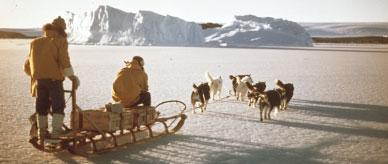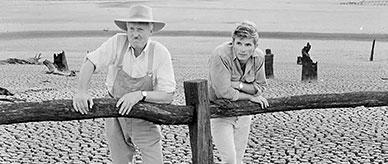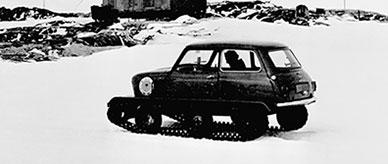
Transcript
Narrator: A strange craft for a strange voyage. HMAS Labuan is ready to leave Melbourne with a relieving party of 12 scientists who will spend the year on Heard Island, the Australian research station in the sub-Antarctic. Heading south on the 3700 mile adventure, Labuan skipper is Lieutenant Commander Dickson.
The vehicle deck of the former tank landing craft makes a good gymnasium to keep the personnel fit and active.
[MUSIC INTERLUDE]
Narrator: In the ward room the expedition leader, Mr Phillip Law, is already planning. Kee Ooi [spelling unknown] is a Chinese biologist from Perth University.
When we sight an iceberg, we know that the Antarctic is really near, although we’re only half way to Heard Island.
[MUSIC INTERLUDE]
Narrator: But now Heard Island itself is looming up, with Big Ben mountains towering 9000 feet above sea level. For the newcomers, one of the few sunny days turns on a sightseeing welcome. HMAS Labuan anchors in Atlas Cove, site of the expedition’s permanent camp.
Twelve men can get through a lot of stores in a year, and the first job is to unload 120 tonnes of food, fuel oil, radio and engine parts.
[MUSIC INTERLUDE]
Narrator: The cargo is ferried to the island by army ducks. The new party will live on this frigid rocky outpost, where the South Pole’s nearer than home, and their closest neighbours are some South African meteorologists, 1400 miles to the west.
[MUSIC INTERLUDE]
Narrator: But the local inhabitants always turn on a warm if inquisitive welcome, with the invitations reading 'white tie and tails'.
A fur seal is another member of the reception committee, and we have no trouble in getting close to a rookery of skewer gulls, the scavengers of the island.
[MUSIC INTERLUDE]
Narrator: Twelve months reading will soon make a dent in that library!
Campbell-Drury demonstrates the home-made wireless which he used to contact Australia. Dr Gilchrist supervises violet ray treatment, which is compensation for lack of sunlight.
Weather expert, Aussie Watt [spelling unknown], discusses problems with his predecessors. The old instructing the new, but all fully experienced technicians.
[MUSIC]
[END]
About this record
This is a black-and-white segment of a newsreel from the Australian Diary documentary series. Titled 'Scientists Go to Antarctica to Study Weather', it shows a team of scientists making their way to Heard Island in 1949 to relieve the previous year's team. The segment opens with HMAS Labuan leaving Melbourne, followed by scenes of the voyage.
As they near shore, the Big Ben volcano on Heard Island comes into view. Stores for the team's 12-month stay are then brought on shore. After a sequence showing local fauna, humorously described by the commentator, the segment ends with the outgoing team briefing their replacements.
Educational value
- This newsreel story celebrates the logistical and human aspects of Australia's post–Second World War commitment to thoroughly explore and undertake scientific investigations in its Antarctic and sub-Antarctic territories. The scientific research program helps Australia defend its claim to its Antarctic territories. The presence of scientific teams also helps to fend off intrusion by others.
- The scientists featured here were the first and second teams to work in the Territory of Heard Island and McDonald Islands (HIMI). The research station was operated by the Australian National Antarctic Research Expeditions from 1947 to 1954.
- Heard Island lies near the meeting point of Antarctic and temperate ocean waters, about 1500 kilometres north of Antarctica and more than 4000 kilometres south-west of Perth. Rainfall is about 1400 millimetres a year and there is constant cloud cover and gale-force westerly winds.
- Because of its location, Heard Island is isolated from the effects of human activity. This is valuable for meteorologists who want to use it as a sub-Antarctic climate-monitoring station. The incoming scientists in this newsreel studied meteorology, volcanism and glaciology.
- The scientists also studied Heard Island's flora and fauna. The island’s ecosystems continue to be pristine—unspoiled by pollution, human activity and intrusion by flora and fauna that do not belong there. For some part of every year, colonies of birds (mainly penguins) and seals are found there. Almost 20 square kilometres of the island—the low coastal areas—are covered with plants, mostly mosses and lichens.
- During the brief summer sailing season, supplies and teams of scientists were vital for the operation of the Heard Island research station, and a suitable ship was essential. HMAS Labuan was an unusual vessel for this task. It was built in the Second World War as a landing ship tank (LST). LST vessels operate by beaching or anchoring in shallow water so that amphibious vehicles can roll off. In 1949, army DUKWs (the 6-wheel-drive amphibious trucks seen in the newsreel) were used for the first time as landing craft at Heard Island.
- The 2054-tonne flat-bottomed ship sailed badly in most seas because it had all its operating parts in the stern. In spite of the happy scenes in the story, life on board must have been very difficult. Landing men and supplies was a hazardous operation at Heard Island and the team had to work as rapidly as possible. Just the previous year, the Labuan had spent more than a week making several near-disastrous attempts to land on the beach.
- Big Ben is a 2750-metre high, 20-kilometre wide volcano in the centre of the 368-square-kilometre island. It has 14 glaciers that radiate outwards. Mount Dixon is another active volcano on the island, lying at its north-west tip. In 1950, soon after this story was filmed, volcanic eruptions resumed after a 40-year break.
- HIMI is now known to represent one of the longest active examples of plume volcanism – volcanoes formed above plumes, the unseen upward movements of hotter parts of the Earth's mantle.
- Ships frequently stopped at Macquarie Island or Heard Island on the way to Antarctica.
Acknowledgments
Learning resource text © Education Services Australia Limited and the National Archives of Australia 2010.
Related themes
Need help with your research?
Learn how to interpret primary sources, use our collection and more.



